Some history on the existing Islamic shrine
Haram al-Sharif is a plaza built on a
hill top in Jerusalem
AT THE HEART OF JERUSALEM is the Noble Sanctuary, Al-Haram
al-Sharif, enclosing over 35 acres of fountains, gardens, buildings and domes. At its
southernmost end is Al-Aqsa Mosque and at its centre the celebrated Dome of the Rock. The
entire area is regarded as a mosque and comprises nearly one sixth of the walled city of
Jerusalem.
The Noble Sanctuary is one of the three most important sites in
Islam.Th |
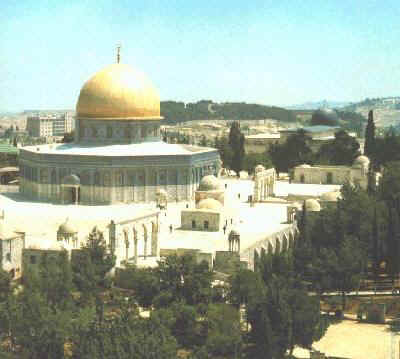
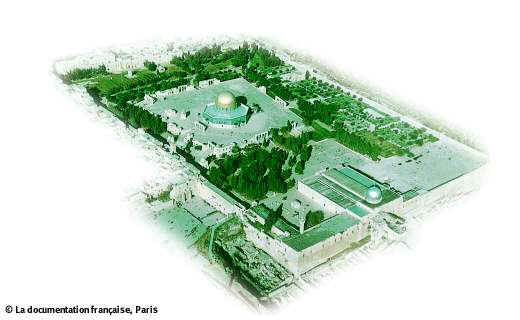
A plot of ' Haram al-Sharif ' on Mount Moriah
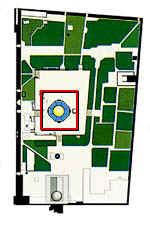
|
|
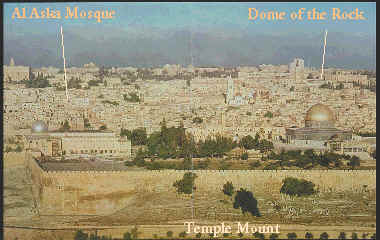
Interior of the Dome |
|
|
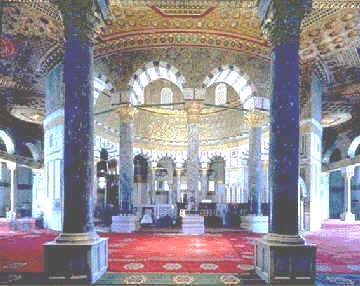 |
|
Noble Rock |
The Noble Rock
is the focus of the interior of the Dome of the Rock, situated directly beneath the lofty
dome and surrounded by the highly ornate inner circular and outer octagaonal arcades. |
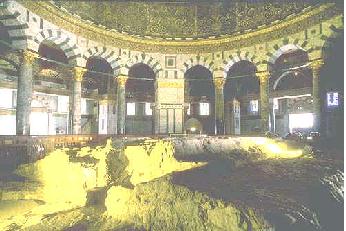 |
The Dome of the Rock, the first Muslim masterpiece, was
built in 687 A.C. by Caliph Abd al-Malik, half a century after the death of the Prophet
Muhammad . The rock marks the site from where Prophet Muhammad
made his Miraaj or Night Journey into the heavens and back to
Makkah |
|
|
|
|
|
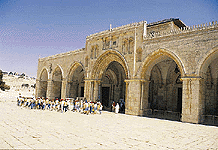
Al-Aska Mosque in 1930

|
The Al-Aska Mosque: The Al-Aska Mosque is the smaller of the domed
Mosques on the temple mount. The local Moslems worship in this mosque and it is open for
touring only after prayer times. Built by the Caliph al-Walid (r.
705-715), of the Umayyad dynasty, El-Aksa is one of the largest and most important mosques
in the Muslim world, and the earliest in Palestine.
Its construction was probably the architectural expression of the destination of
Muhammad's Night Journey and of the place where his ascension to heaven occurred. The
mosque was beautiful and vast twice the size of today's structure. The original mosque was
destroyed in an earthquake in the middle of the eighth century and restored by the
Abassids toward the end of that century. Other than a few pieces of wood bearing carvings
of floral images, nothing remains of the decorations of the original mosque. Most of those
in today's mosque date from medieval times. |
Wailing Wall
The Jews believe this 'Haram al-Sharif' ' support wall is
part of Solomon's temple
Jews
The Wailing Wall, or Western Wall, is held by most Jews to be the remnant of
the Second
Temple, and thus has become an object of veneration. It forms the base of the
Haram
al-Sharif, where stands the Dome of the Rock and al-Aqsa mosque.
Muslims
This
wall is also known to Muslims as al-Buraq, considered a holy place because it was here
that
Muhammed tethered his winged steed on his journey to Jerusalem. Access to the
wall was
through
a passage in the Magrebi residential quarter, completely destroyed by Israel in 1967.
|
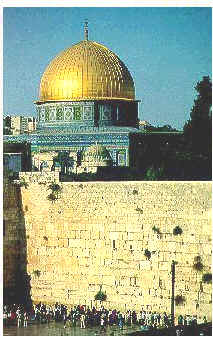
|
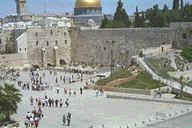
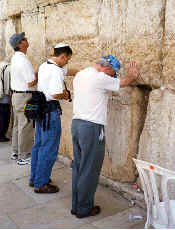
|
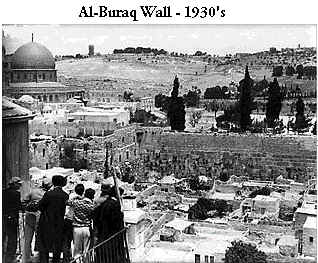
|
|
Chronological History
| 1000 BC. |
King Solomon built
the First Temple around |
| 586 BC |
The Temple was
destroyed first by the Babylonian king, Nbouchath Nassar in |
| 11 BC. |
Adomite who
converted to Judaism,and built the Second Temple in |
| 70 AD |
Titus, the Roman
General occupied Jerusalem in and destroyed the Temple for the second time |
| 135 AD |
Hadrian, the
Roman, and completely removed all the ruins and traces of the Temple |
|
|
|
|
|
|
|
|
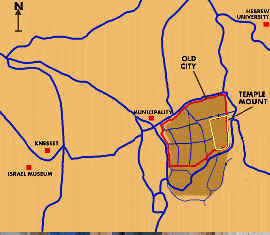 |
Map
color legend |
|
Early Muslim Jerusalem |
|
|
Modern Jerusalem |
|
|
|
Jews were bared from Jerusalem until the Muslim Khalif Omar lbn al Khattab entered
Jerusalem in 635 AD and signed the Constitution with Patriarch Safronius who asked him to
include a text that said that no Jews will live in Jerusalem, i.e. Jews were to be
forbidden to live with Muslims and Christians in Jerusalem. It remained so until some Jews
came from Spain and lived in Jerusalem in the sixteenth century.
According to the Jewish Encyclopaedia, under the title "Jerusalem", the Jews
did not pray in front of the Buraq Wall (The Western Wall) prior to the sixteenth century,
but they prayed at the Mount of Olives, i.e. the story of the Temple
was not connected to the Western Wall. Jewish interest in this wall started in the
twentieth century.

The Night
Journey
Glory be to He
Who carried His servant by night,
from the Holy Mosque
to the Furthest Mosque,
the precincts of which
We have blessed.
so that We might show him
some of Our signs.
Surely He is the All-Hearing,
the All-Seeing.
------------------Sura al-Isra'
------------------Qur'an 17:1 |
A Buraq
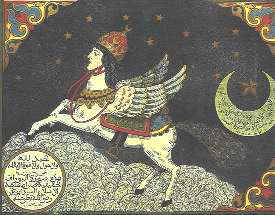
|
In the ninth year of the Prophet's mission, about 620 AD, Muhammad
rose in the middle of the night to visit the Sacred Mosque in Makkah. After a time of
worship he fell asleep near the Ka'aba. The angel Gabriel came to him and woke him from
his slumber. He led the Prophet, peace and blessings be upon him, to the edge of the
sacred Makkan mosque. Awaiting them was al-Buraq, a white winged beast "whose each
stride stretched as far as the eye could see." Muhammad mounted al-Buraq and sped
northwards with Gabriel to Al-Aqsa Mosque in Jerusalem, the Furthest Mosque.
When they reached Jerusalem the Prophet dismounted and prayed near the Rock. Abraham,
Moses, Jesus and other prophets, peace be upon them all, gathered together to pray behind
him. Muhammad was presented a vessel of wine and a vessel of milk. The Prophet chose the
milk and Gabriel said, 'You have chosen the true religion'.
The Prophet then embarked on the ascension (Miraj) in which he,
peace and blessings be upon him, received the command to pray five times a day and the
revelation encapsulating the beliefs of Islam:
"The Messenger believes in what was sent down to him from his Lord. And the
believers; each one believes in Allah and His angels and in His books and His messengers.
We make no division between any one of His messengers. And they say: We hear and we obey.
Oh Lord, grant us Thy forgiveness; unto Thee we return." Qur'an II/285














